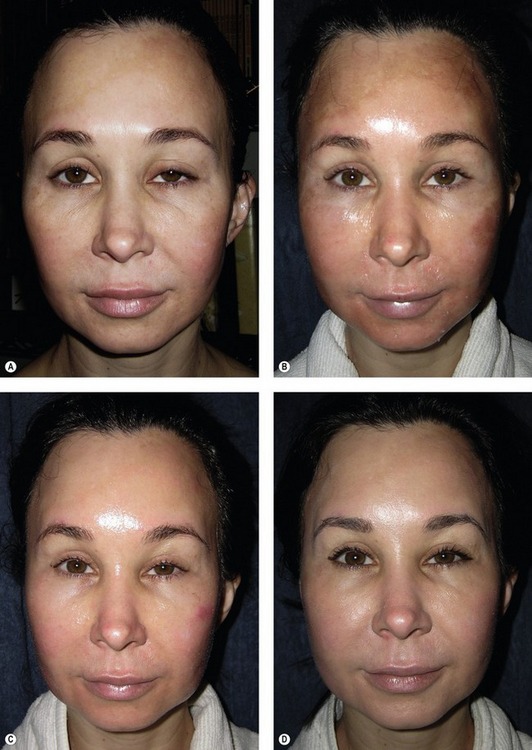CHAPTER 79 Chemical peels and dermabrasion
Physical evaluation
• Skin type is the most important factor. The Fitzpatrick classification (Table 79.1) identifies six skin types based on reaction to sun exposure; the lower the Fitzpatrick type, the less melanin in the skin. In general, patients with darker skin types have a greater tendency to develop post-treatment hyperpigmentation, while patients with light skin are more prone toward post-treatment hypopigmentation.
• Complexion (degree of pigmentation) determines the ability of the skin to withstand environmental injury.
• Skin thickness, pore size and sebaceous secretions influence pretreatment and safety margin.
• Degree and level of actinic damage (photodamage) influence treatment.
• Depth and location of wrinkling and gravitational changes must be considered.
• Hair and eye color is useful in the evaluation of resurfacing patients.
• History of herpes, poor wound healing, allergies, pigmentary problems.
• Patient lifestyle and acceptable downtime must be considered.
Table 79.1 Fitzpatrick skin classification
| Type | Color | Reaction to sun exposure |
|---|---|---|
| I | White | Always burns/never tans |
| II | White | Usually burns/tans with difficulty |
| III | White | Sometimes mild burn/average tan |
| IV | Moderate brown | Rarely burns/tans with ease |
| V | Dark brown | Very rarely burns/tans very easily |
| VI | Black | Never burns/tans very easily |
Data from Fitzpatrick TB. The validity and practicality of sun-reactive skin types I through VI. Arch Dermatol 1988;124:869.
Anatomy
Aging of the skin affects both the epidermis and dermis and is exacerbated by actinic damage. Aging causes epidermal hyperplasia, atrophy and dysplasia, producing an atrophic and flat epidermis. Dermal connective tissue shows progressive diminution with loss of much of the reticular dermis. Collagen fibers become degenerated and thickened. Reduction of the amount of collagen leads to thinning of skin. The dermis of actinically damaged skin exhibits elastosis, the presence of thickened, degraded elastic fibers. Separating the solar elastotic material from the epidermis is a thin zone of normal appearing dermis largely composed of collagen, called the Grenz zone. Additionally, aging causes loss of dermo-epidermal papillae and reduction in the melanocytes. These histological changes are responsible for the clinical signs of aging and sun damage including wrinkling, laxity, and pigment changes. Cutaneous resurfacing is intended to reverse these changes.










